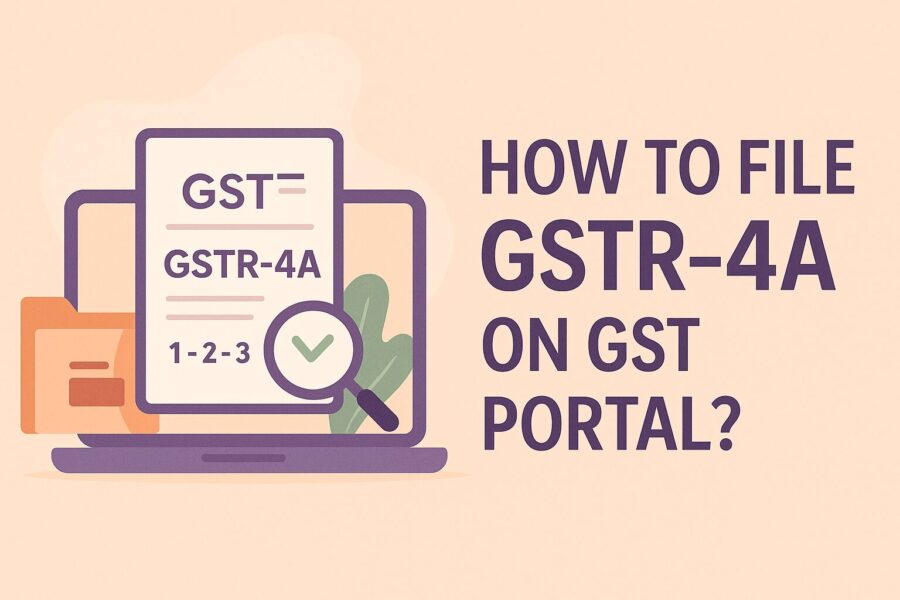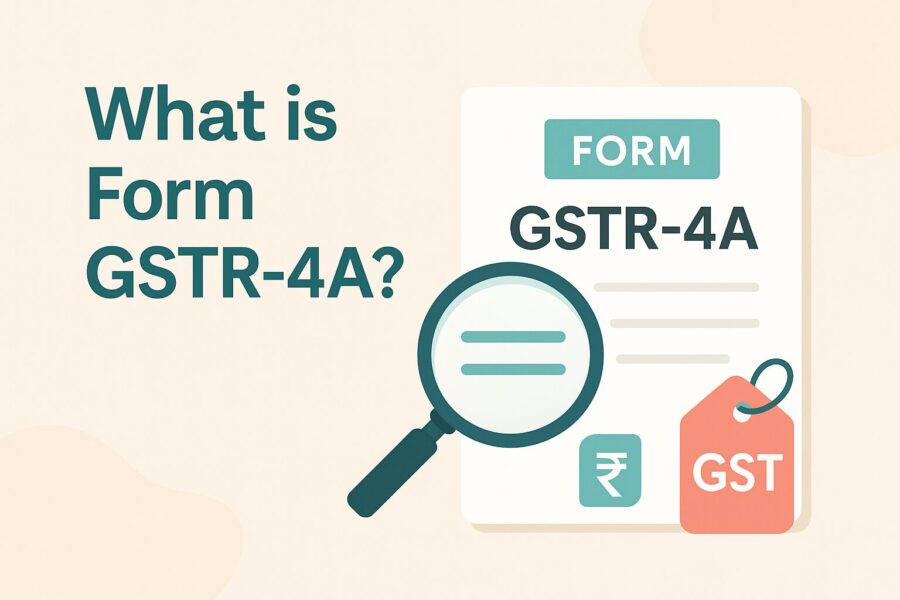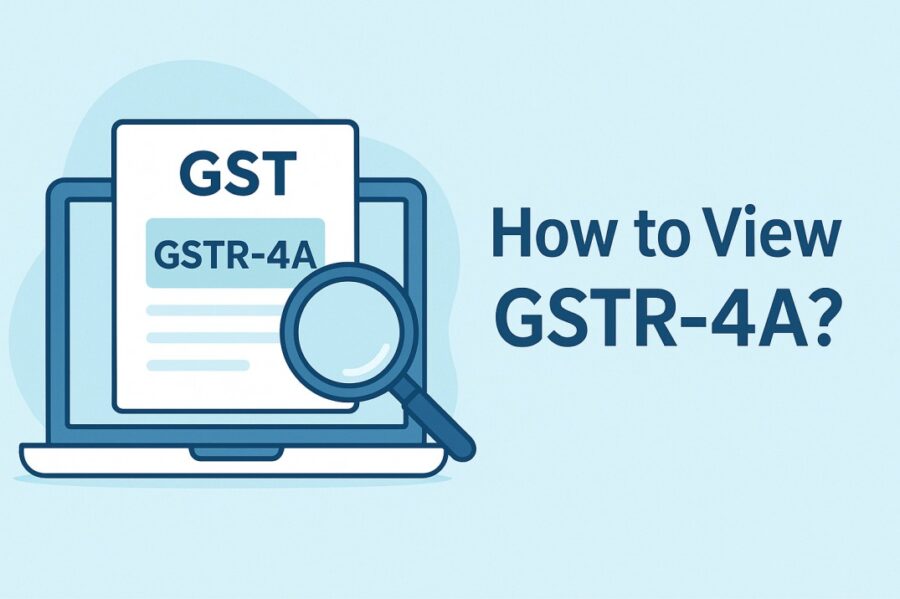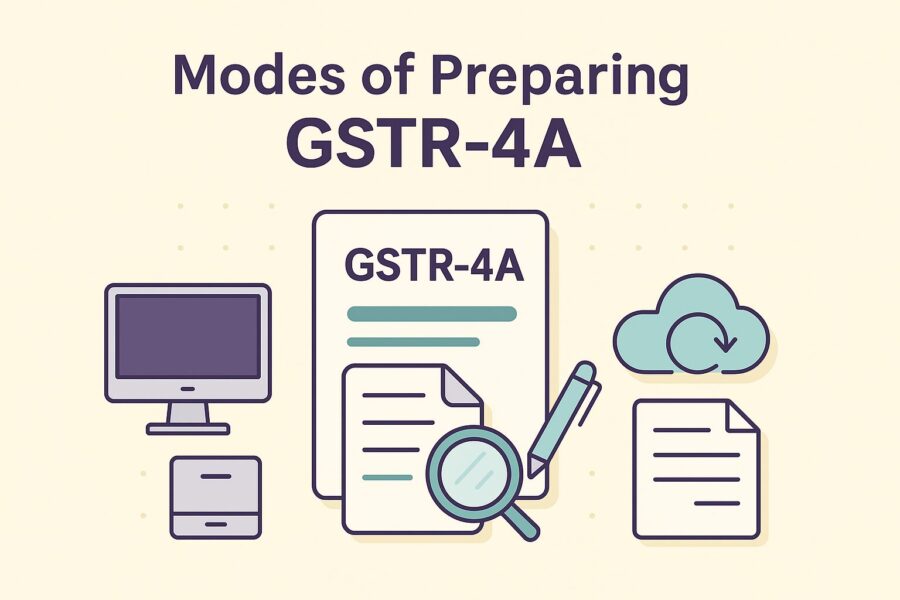How to File GSTR 4A on GST Portal?
- 6 Aug 25
- 9 mins

How to File GSTR 4A on GST Portal?
Key Takeaways
- GSTR-4A is a system-generated, read-only form that reflects inward supplies for composition taxpayers.
- It auto-populates from suppliers’ GSTR-1 and GSTR-5 filings, requiring no manual input from the taxpayer.
- Taxpayers must regularly review GSTR-4A to ensure accuracy before filing the annual GSTR-4.
- GSTR-4A can be accessed via the GST portal with specific steps for each section, including invoices and notes.
- Timely reconciliation of GSTR-4A helps avoid mismatches and ensures smooth GST compliance.
GSTR-4A is a read-only, auto-drafted return that provides purchase-related tax details specifically for composition dealers. Since it is auto-populated from suppliers’ filings, composition taxpayers do not need to worry about how to file GSTR-4A on the GST portal. However, reviewing GSTR-4A regularly is essential to identify and prevent discrepancies.
This guide makes the compliance journey easier and less stressful for registered persons by breaking down the step-by-step procedure for viewing GSTR-4A directly from the GST portal.
What is Form GSTR-4A?

The system uses the data that composition dealers' suppliers file in GSTR-1 or GSTR-5 to create the auto-drafted return known as GSTR-4A. So, you must know how to file GSTR-4A on the GST portal because a composition taxpayer's inward supplies are reflected in this return. Only when the supplier uploads invoice details does this form get filled in.
The information will show up in the following quarter's GSTR-4A if a supplier files GSTR-1/5 after the composition dealer has already filed their Form GSTR-4 return for that tax period. For example, the respective invoices will appear in the GSTR-4A for July–September if the supplier file returns GSTR-1 for July and GSTR-4 for April–June.
How to File GSTR 4A?
For composition taxpayers, GSTR 4A is a view-only form. This is an auto-drafted file that is made from the data that GSTR-1 and 5 provided. Let's take a look at how to view the details in this form:
Step 1: Visit the GST portal and log in with the correct credentials.
Step 2: Find the "Services" section and click "Return" to get back to "Dashboard".
Step 3: In the “File Returns” page, one has to select the “Return Filing Period” and “Financial Year”.
Step 4: After providing the year one wants to view the details for, click on “Search”.
Step 5: There will be a GSTR 4A tile on screen. Select “View”.
Step 6: If the number of invoices is more than 500, then you have to download it.
Step 7: To download it, click on the “Generate File” option.
Step 8: One can see the details on screen (Sections: 3A, 3B -B2B Invoices, 4 - Credit/Debit Notes, 4 - Amendments to B2B Invoices, 4 - Amendments to Debit Notes/Credit Notes).
How to View GSTR-4A?

GSTR-4A can be viewed online via the GST portal, subject to knowing how to file GSTR-4A on the GST portal and specific requirements:
Basic Requirement for Viewing GSTR-4A
- GSTR-4A tile can only be viewed online from the tile names if there are fewer than 500 invoices for a given tax period.
- The user must use the "GENERATE FILE" option to download and view invoices offline if there are more than 500.
Steps to View GSTR-4A on the GST Portal
- Enter your credentials to access the GST portal.
- Go to Services > Dashboard > Returns.
- Click the Search tile after selecting the Financial Year and Return Filing Period.
- Click the "VIEW" tile on screen in the GSTR-4A section.
- Click Download > Generate File if there are more than 500 invoices.
GSTR-4A Display Sections
B2B, 3A, and 3B Bills: View supplies coming in from approved vendors.
- To view supplier invoices, click GSTIN.
- To view invoice details, click the invoice number.
- To view supplier notes, click on GSTIN.
- For more information, click Note Number.
Modifications to Business-to-Business Invoices:
- To view updated invoices, click GSTIN > invoice number.
- Click the GSTIN and then the note number to view the amended notes.
When Can GSTR-4A Be Viewed?
Once the suppliers upload invoice details in their GSTR-1 or Form GSTR-5, a composition dealer can view GSTR-4A. This automatically generated form reflects the inward supplies made to the composition taxpayer who knows how to file GSTR-4A on the GST portal.
However, the invoice data for the same period will not show up if the supplier files GSTR-1 or GSTR-5 after the dealer has already filed their Form GSTR-4 for that particular tax period. Rather, the system will automatically enter it in the GSTR-4A for the upcoming tax period.
Consequently, the timing of the supplier's GSTR-1 or GSTR-5 filing is the only factor that affects the availability of GSTR-4A.
Modes of Preparing GSTR-4A

There are two main ways to prepare GSTR-5A, particularly for intra state supply transactions. First, you can submit the return by going to the official GST Portal and directly entering the necessary information. Therefore, business entities or individuals frequently employ this technique for a simple manual filing procedure.
Taxpayers can also use third-party apps offered by Application Software Providers (ASPs) that are connected with GST Suvidha Providers (GSPs). This method improves accuracy and efficiency by enabling automated data preparation and submission.
Hence, depending on how to file GSTR-4A on the GST portal, the amount and complexity of the taxpayer's transactions, these approaches provide flexibility in preparing returns.
Details of Form GSTR-4A
Under the GST regime, composition dealers use the automatically generated GSTR-4A return form. The system displays the invoice and credit/debit note details that the supplier uploads in their respective Form GSTR-1 or GSTR-5 returns in four main sections.
The following section provides a description of each part and instructions on how to file GSTR-4A on the GST portal and view the details:
3A, 3B -B2B Invoices
This section includes the supplies received from registered suppliers. The system automatically fills the respective returns when suppliers upload or save their invoices in GSTR-1 or GSTR-5.
How to View:
- Step 1: Select the "3A, 3B – B2B Invoices" tile. The supplier details page for B2B invoices opens.
- Step 2: Click the GSTIN hyperlink under supplier details to view all uploaded invoices.
- Step 3: To view particular invoice details, click the invoice number hyperlink.
- Step 4: Details of each item's invoice, such as the tax amount and future supply value, are shown on the screen.
4(Credit/Debit Notes)
This section shows the credit and debit notes that suppliers upload with their GSTR-1/5 returns.
How to View:
- Step 1: Select the "4-Credit/Debit Notes" tile. This takes you to the supplier details page for credit/ debit notes.
- Step 2: To see the supplier-by-supplier list of notes, click the GSTIN hyperlink.
- Step 3: To view the specifics of each note, click the hyperlink for the credit/debit note number.
- Step 4: The entire credit/debit note information, including the amount, reason and associated invoice, will be shown.
4 (Amendments to B2B Invoices)
This section includes all of the modified B2B invoices that suppliers submitted with their most recent GSTR-1 or GSTR-5 returns.
How to View:
- Step 1: Select the "4-Amendments to B2B Invoices" tile. The page for Amending B2B Invoices – Supplier Details appears.
- Step 2: Click the GSTIN hyperlink to see which suppliers have changed their invoices.
- Step 3: Click the invoice number hyperlink to view the updated invoice.
- Step 4: Updated invoice details for each item will be displayed on the screen.
4 (Amendments to Credit/ Debit Notes)
This section displays the updated credit/debit notes that suppliers have made changes to in their Form GSTR-1/Form GSTR-5 filings.
How to View:
- Step 1: Select the "4-Amendments to credit/ debit notes" tile. This brings up the supplier details page for amending credit/ debit notes.
- Step 2: Click the GSTIN hyperlink to view the updated notes.
- Step 3: Click the hyperlink for the credit/ debit note number to view specific information.
- Step 4: The most recent debit/credit notes with all pertinent information will be shown.
Conclusion
As an auto-drafted return, GSTR-4A offers crucial information about the credit/debit notes, inbound supplies and supplier amendments submitted with GSTR-1 and GSTR-5 returns. Simply put, taxpayers do not need to worry about how to file GSTR-4A on the GST portal.
However, this form serves as a valuable reference when filing Form GSTR-4, even though no direct action is required on GSTR-4A itself. Therefore, you must review and reconcile these forms on time to ensure compliance and error-free GST return filing.
💡If you want to streamline your payment and make GST payments via credit card, consider using the PICE App. Explore the PICE App today and take your business to new heights.
Is GSTR-4A required to be filed by composition taxpayers?
Why is it important to review GSTR-4A even though it’s non-editable?
When can a taxpayer view GSTR-4A on the GST portal?
What are the different sections in GSTR-4A and what do they contain?
3A, 3B - B2B Invoices for inward supplies.
4 - Credit/Debit Notes issued by suppliers.
4 - Amendments to B2B Invoices and Credit/Debit Notes showing supplier corrections.
Each section provides clickable details such as GSTIN, invoice numbers, amounts, and reasons, helping dealers track every transaction.
 By
By 
















